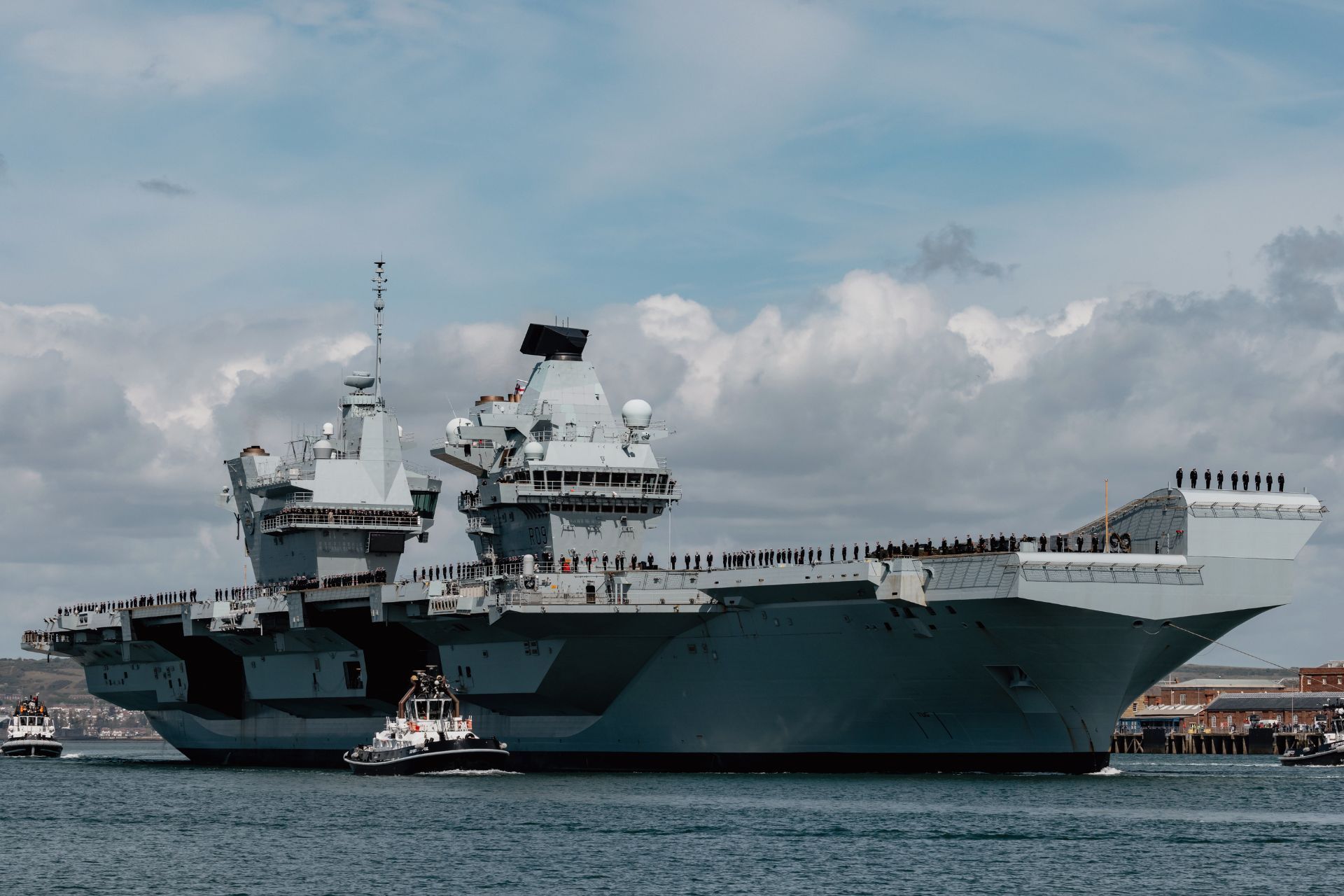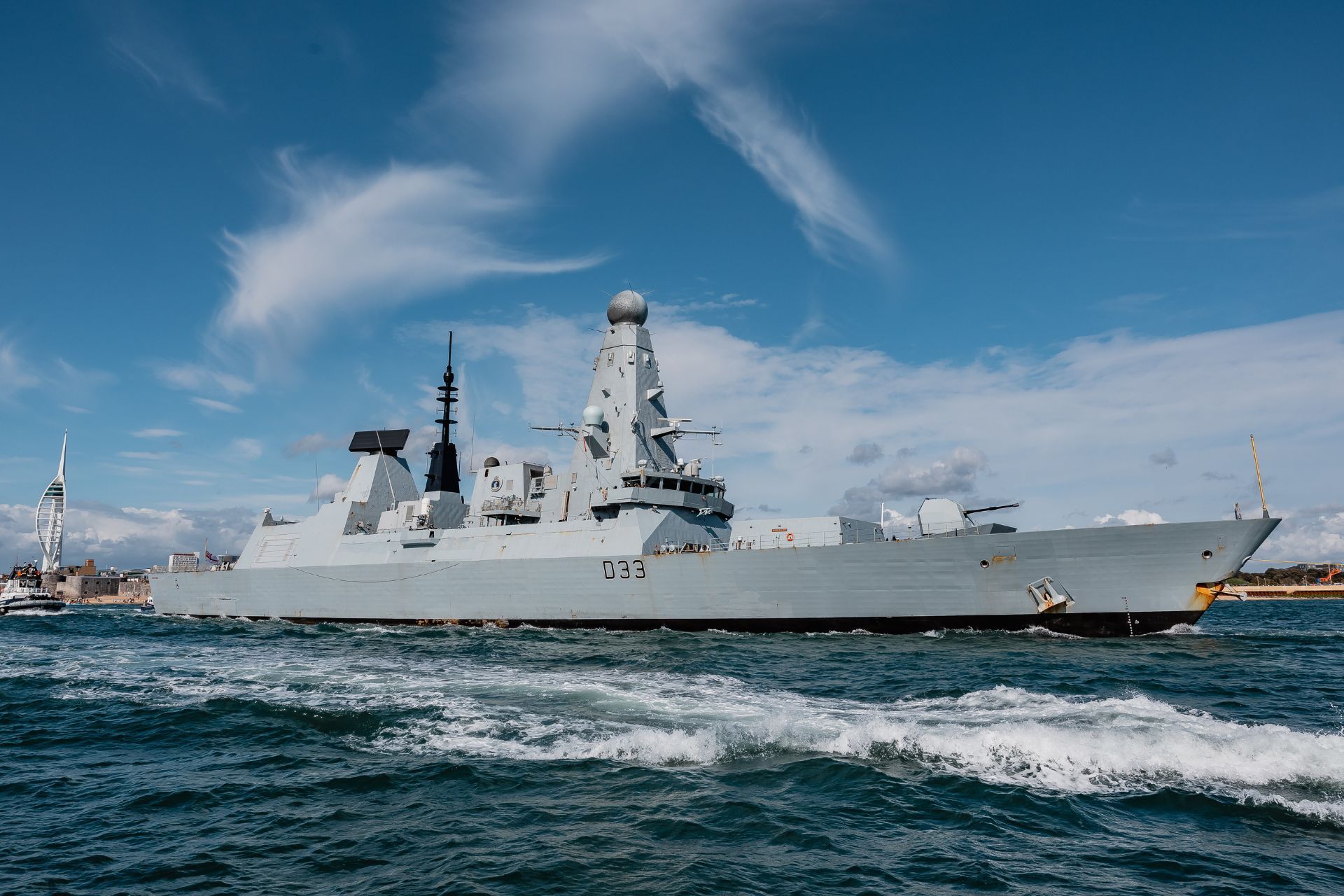Breaking News
UK Strengthens Indo-Pacific Presence with 8-Month Aircraft Carrier Group Deployment.
The United Kingdom has initiated its primary naval operation of 2025 with the deployment of the Carrier Strike Group led by the aircraft carrier HMS Prince of Wales. Thousands of people gathered along Portsmouth’s historic waterfront to bid farewell to the 1,600 crew members on board, in a long-standing tradition that marks key Royal Navy departures. This event signals the start of Operation Highmast, a planned eight-month deployment intended to demonstrate the UK’s capacity for maritime power projection and its commitment to allied solidarity from the Atlantic to the Pacific.

HMS Prince of Wales leaves HMNB Portsmouth as it deploys on an eight-month mission (Picture source: British MoD)
Shortly after the departure of the Prince of Wales, the destroyer HMS Dauntless left port to join the group. Other vessels, including the frigate HMS Richmond, the Royal Fleet Auxiliary tanker RFA Tidespring, and the Canadian frigate HMCS Ville de Québec, sailed from Plymouth. Meanwhile, two Norwegian vessels—the replenishment tanker HNoMS Maud and the frigate HNoMS Roald Amundsen—departed Bergen to rendezvous with the group in the English Channel, following a formal send-off from Vice Admiral Sir Martin Connell, the Royal Navy’s Second Sea Lord. The naval task force includes around 2,500 personnel, primarily British, with participation from Norwegian, Canadian, and Spanish forces. This number is expected to rise to approximately 4,500 during the most intensive phases of the deployment.
The UK Carrier Strike Group (CSG) serves as the core instrument of the nation’s long-range naval power projection. Built around the Queen Elizabeth-class aircraft carrier HMS Prince of Wales—a 65,000-tonne vessel capable of reaching speeds of 25 knots and operating up to 10,000 nautical miles without refuelling—the group is equipped with a mix of next-generation platforms. The flagship carries F-35B Lightning II aircraft, capable of short take-off and vertical landing, combining low observability with multi-role combat capability. The carrier is accompanied by a Daring-class (Type 45) air-defence destroyer, one or more Duke-class (Type 23) frigates specialized in anti-submarine warfare, an Astute-class nuclear-powered attack submarine with unlimited range, and a Royal Fleet Auxiliary tanker providing logistical support.
The CSG’s air wing includes Merlin helicopters used for heavy lift and anti-submarine operations (with a lifting capacity of 3.8 tonnes), as well as lighter Wildcat helicopters for reconnaissance and tactical support. Described by the Royal Navy as one of the most modern formations of its kind, the Carrier Strike Group is designed to carry out complex joint operations over extended distances, in coordination with allied forces. It serves as a strategic deterrent and a tool of naval diplomacy, capable of engaging in a wide range of scenarios from humanitarian assistance to high-intensity conflict.
This deployment marks the second major mission of the UK Carrier Strike Group, following the 2021 operation led by HMS Queen Elizabeth, which took place under global COVID-19 restrictions. The current mission unfolds in a substantially altered strategic context, characterized by heightened geopolitical instability and evolving security dynamics. Command of the operation has been entrusted to Commodore James Blackmore, who leads the embarked staff aboard the Prince of Wales. He emphasized that the operation reflects the UK's commitment to the international rules-based order, NATO security objectives, and national defence priorities.

HMS Dauntless leaves HMNB Portsmouth to form part of the Carrier Strike Group as it deploys on an eight-month mission (Picture source: British MoD)
Shortly after the departure of the Prince of Wales, the destroyer HMS Dauntless left port to join the group. Other vessels, including the frigate HMS Richmond, the Royal Fleet Auxiliary tanker RFA Tidespring, and the Canadian frigate HMCS Ville de Québec, sailed from Plymouth. Meanwhile, two Norwegian vessels—the replenishment tanker HNoMS Maud and the frigate HNoMS Roald Amundsen—departed Bergen to rendezvous with the group in the English Channel, following a formal send-off from Vice Admiral Sir Martin Connell, the Royal Navy’s Second Sea Lord. The naval task force includes around 2,500 personnel, primarily British, with participation from Norwegian, Canadian, and Spanish forces. This number is expected to rise to approximately 4,500 during the most intensive phases of the deployment.
The UK Carrier Strike Group (CSG) serves as the core instrument of the nation’s long-range naval power projection. Built around the Queen Elizabeth-class aircraft carrier HMS Prince of Wales—a 65,000-tonne vessel capable of reaching speeds of 25 knots and operating up to 10,000 nautical miles without refuelling—the group is equipped with a mix of next-generation platforms. The flagship carries F-35B Lightning II aircraft, capable of short take-off and vertical landing, combining low observability with multi-role combat capability. The carrier is accompanied by a Daring-class (Type 45) air-defence destroyer, one or more Duke-class (Type 23) frigates specialized in anti-submarine warfare, an Astute-class nuclear-powered attack submarine with unlimited range, and a Royal Fleet Auxiliary tanker providing logistical support.
The CSG’s air wing includes Merlin helicopters used for heavy lift and anti-submarine operations (with a lifting capacity of 3.8 tonnes), as well as lighter Wildcat helicopters for reconnaissance and tactical support. Described by the Royal Navy as one of the most modern formations of its kind, the Carrier Strike Group is designed to carry out complex joint operations over extended distances, in coordination with allied forces. It serves as a strategic deterrent and a tool of naval diplomacy, capable of engaging in a wide range of scenarios from humanitarian assistance to high-intensity conflict.
This deployment marks the second major mission of the UK Carrier Strike Group, following the 2021 operation led by HMS Queen Elizabeth, which took place under global COVID-19 restrictions. The current mission unfolds in a substantially altered strategic context, characterized by heightened geopolitical instability and evolving security dynamics. Command of the operation has been entrusted to Commodore James Blackmore, who leads the embarked staff aboard the Prince of Wales. He emphasized that the operation reflects the UK's commitment to the international rules-based order, NATO security objectives, and national defence priorities.


























